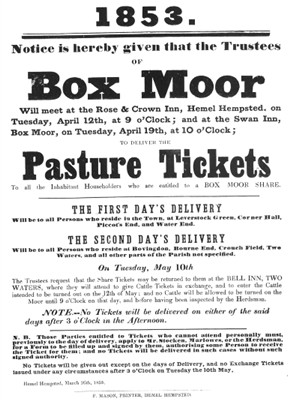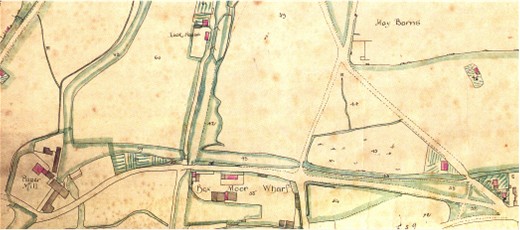
Royalty and Commoners
Four Hundred Years of the Box Moor Trust
by Joan & Roger Hands
The Box Moor Trust, Hemel Hempstead, 2004
Hardback, 33.5*24.5 cm, viii + 264 pages, copiously illustrated
ISBN0 9504532 2 6 £25.00
In 1574 Elizabeth I gave Robert Dudley, Earl of Leicester, some land in Hemel Hempstead which had previously been associated with the monastery at Ashridge. This was sold and in 1581 the water meadows known as Box Moor were secretly purchased on behalf of the inhabitants of Hemel Hempstead and Bovingdon. In 1594 these lands were conveyed to sixty-seven Feoffes (trustees), to be held in trust for ever. The trust still exists and now consists of nearly 500 acres of land which play an important part in the life of the neighbourhood.
 Contents
Contents
-
In the Beginning
-
The Impact of Roads, Canals and Railways
-
The Box Moor Estate
-
Recreation, Fresh Air and Exercise
-
Benefits to the Local Community
-
Administration of the Trust
-
Environmental and Educational Aspects
-
Box Moor Trust Property
-
Past, Present and Future
Appendices
-
Conveyance of Box Moor 1594
-
Alphabetical List of Feoffed in the Box Moor Act 1594-1808
-
Trustees 1809-2003
-
The Public Inquiry 1896 - Response by the Charity Commission
-
Proposed Scheme of the Charity Commissioners 1930
-
The Charity Commission Scheme 2000
-
Box Moor Pingos
-
Early Settlement of Box Moor
-
Botanical Record (Fishery Moor, Roughdown Common, Sheethanger Common, Further Roughdown, Bovingdon Brickworks, Water Survey)
-
Boxmoor Right of Pasture Plaques and Grazing
-
Bye Laws of the Box Moor Trust
-
Petition to the Box Moor Trustees 1835
Bibliography Glossary Index
This is a major work which describes not only the history of Box Moor, but also its past and present role in the local community and the environmental role it now plays in fostering wild life. For instance Part IV includes sections on the Boxmoor Baths (the swimming pool by the canal), cricket (an area was levelled for a cricket pitch as early as 1836, and games are still regularly played on the Moor), golf (the Boxmoor course opened in 1890), rugby and football, all well illustrated with pictures.

Small section of George Alexander Smith's map of the Box Moor Estate in 1842
(To help you work out where this is, the south west end shows the paper mill at Two Waters, with the River Bulbourne coming in from the north and the River Gade coming from the east. The area in the south east corner is now occupied by the Magic Roundabout and the road running east-west past Box Moor Wharf (now B&Q store) is now the main road toward the modern A41 by-pass. The Grand Union Canal runs north-south past the wharf, and a local and lockkeepers cottage is shown.)
Rather than try and comment on everything I decided I would look in more detail at Part II, as transport is an important part of local history. There is a discussion of the possible early route ot the Roman Road called Akeman Street, and mention of the Sparrows Herne Turnpike, formed in 1762 and wound up in 1873, which ran along the line of the old A41 (now A4251) before the modern A41 road was built. The account would not be complete without details of how the Tring mail was seized by a highway robber in 1801 and details are given of the paper mill at Two Waters. The coming of the Grand Junction Canal (as it was then called) clearly had implications for the Feoffes and this is well described. The money raised by the sale of land to the canal company led to the 1809 Act which formalised the position of the trust. The coming of the railways resulted in the main London to Birmingham line being built across the Moor, and later there was a link with the Harpenden to Hemel Hempstead railway. The latest developments - the A41 bypass - is discussed in a later section
My conclusion is that the book is a very interesting and attractive account of an unusually successful 400 year old trust, which has played an important part in the history of both Hemel Hempstead and Bovingdon, and also in the development of transport routes through the Chilterns in West Hertfordshire. If your ancestors came from the area (or you live there) this book is well worth getting. The index for the body of the book contains plenty of names - which will please the genealogist - although care should be taken as the lists in the appendix are not indexed. The book also shares a fault with perhaps 90% of similar works - in that the sources used are often not identified. This means that if you find a mention of your ancestor you may have difficulty in going back to the primary sources to verify and expand the information. An example of a minor problem about sourcing is that the book mentions the "Wicked Lady of Markyate" as if the story were true rather than a 19th century composite legend, much repeated and expanded in the 20th century (see The Wicked Lady of Markyate Cell). However such details should not put you off purchasing this excellent book.
See the boxmoortrust.org.uk web site for more about the Trust and details of the book.
|
Donated copy for review |
See also Locating
Books
Available from the publisher and some local
outlets
If you can add to the information given above tell me.
Page created November 2004

